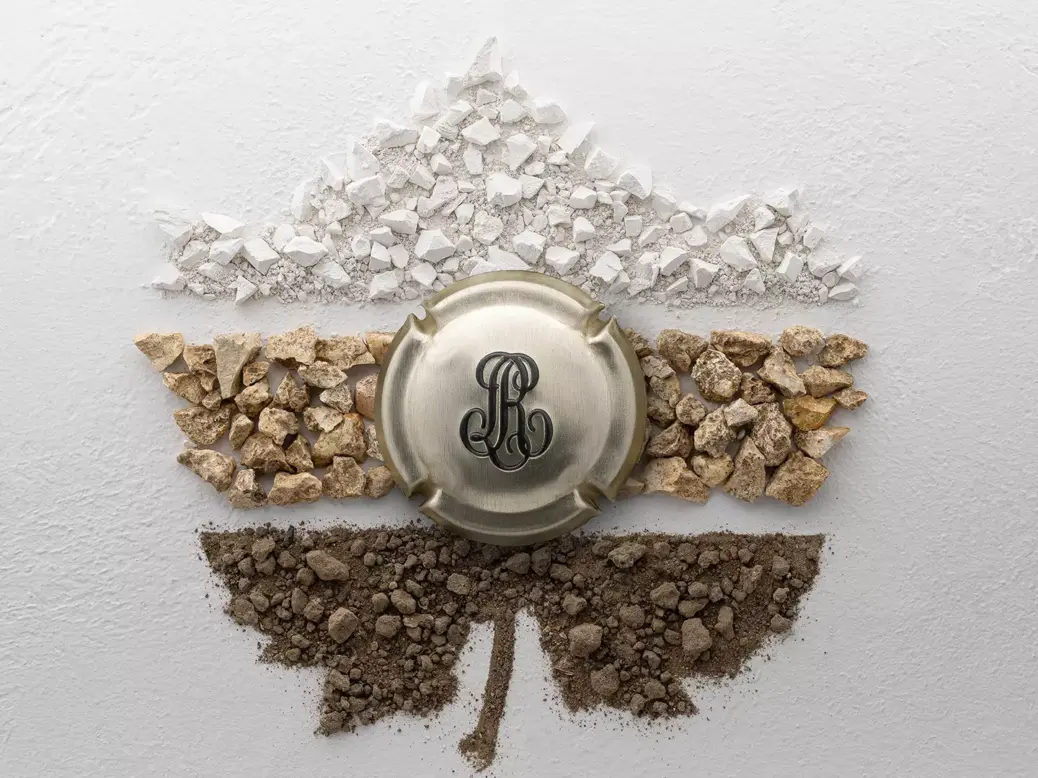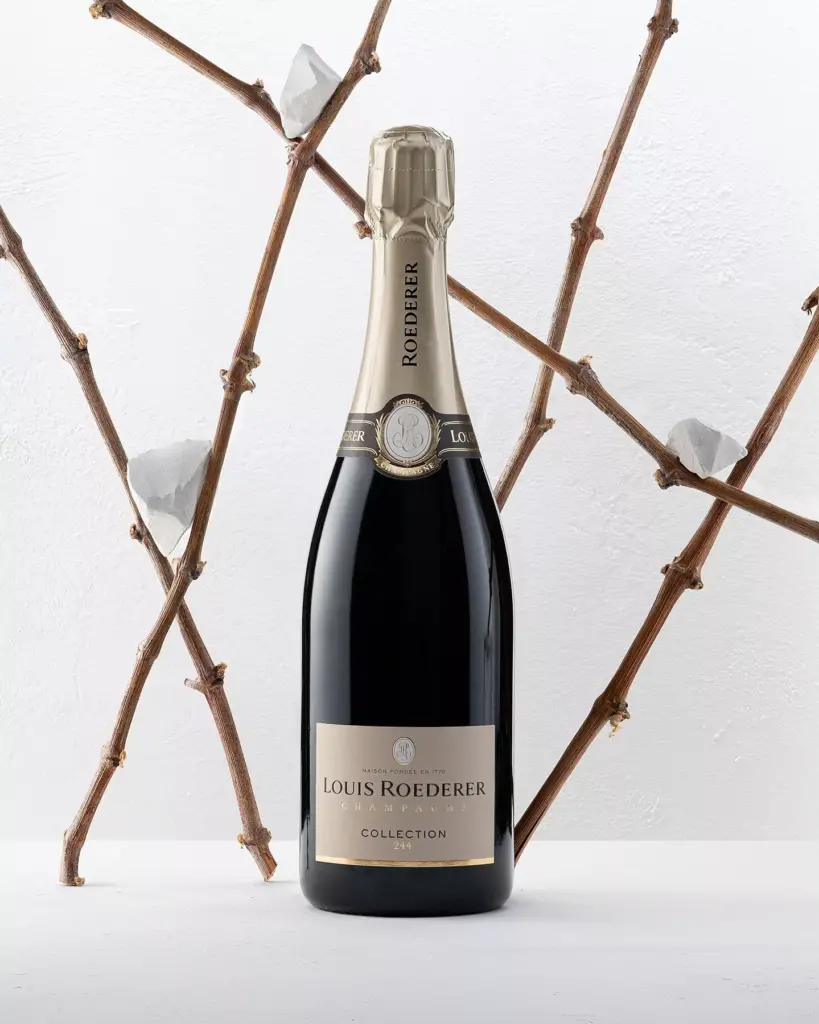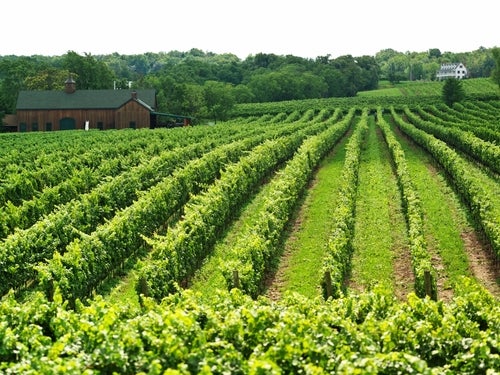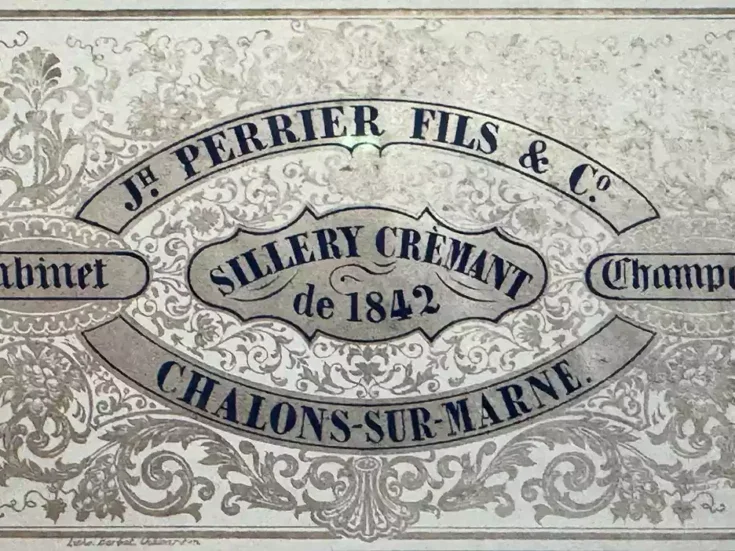
Simon Field MW reports from the launch of Louis Roederer Collection 244, the third edition of the house’s Multi-Vintage series, and learns how its style and production have been shaped by climate change.
“What is the difference between a Non-Vintage and a Multi-Vintage,” asked Alice, looking intently into the glass of the smart Champagne bottle in front of her. “It’s obvious, my dear,” replied the White King kindly, as he proceeded to explain the difference, in some detail, over the next couple of hours.
So, to the Caledonian Club in Mayfair and a virtuoso performance by Jean-Baptiste Lécaillon, the most influential of Champagne’s chefs de caves and, latterly, an apologist for the new face of Non-Vintage Champagne. New-ish, to be fair, as Jacquesson have been advocates for more than two decades, alongside other notable houses such as Krug. In short, the crux of the debate centers on whether each release of a House’s Non-Vintage wine—its signature, its flagship—should aspire to a consistent, immediately recognizable style, or whether it should cleave more to the identity of the base year in question, which usually makes up at least half of the assemblage. Closer to Vintage, then, but topped up with reserve wines in the name of structural harmony and, inevitably, complexity. “I am a conflicted person,” says Jean-Baptiste, somewhat revealingly, at one point. The aim is not to replicate the Vintage wine—what would be the point of that? But neither is it to follow a specific template, or recipe, as was the case with Brut Premier. It is a risk to forsake a style that, in the case of Brut Premier, has become firmly established since its creation in 1982. Extremely popular, too.
Jean-Baptiste is unapologetic. The presentation is eloquent and thought-provoking, and not, to be fair, without the occasional aphoristic flourish. This is a “revolution” and it shapes the “future of Champagne.” It is as a result of a 25-year project, with a distinct historical perspective (Louis Roederer was founded in 1777); Jean-Baptiste mentions his study of the house archives, which date back to 1832, and which, he advises, rehearse the embryonic principle that has now crystallized.
Why now? Simple… it’s down to climate change. The quest for ripeness has been turned on its head; freshness is all in the face of an increasingly unpredictable and occasionally actively malevolent natural backdrop. The upshot has resulted in earlier and warmer harvests, with an accelerated maturity (“an opportunity to harvest extra-mature grapes at the end of their earlier harvests”), resulting in riper and healthier fruit, with less botrytis evidenced. As a result, the composition of the grapes has changed, with more extract bequeathing more flavor and phenolic power, but also less acidity and less nitrogen—both resulting in rounder, creamier, fleshier wines. An embarrassment of riches? A challenge to the concept of tension and marginal edginess? Maybe, says Jean-Baptiste.
The winemaker, however, is far from impotent when it comes to his move: “Since 1982 our strategy has been to embrace…not fight against… this new environment, and we have done it by means of a complete cultural change.” Jean-Baptiste cites the launch of the Roederer “Laboratory of Climate Change” in Cumières, which, inter alia, yielded its Brut Nature (Starck) cuvée, which first appeared in 2006. “We embrace climate change,” he says, while acknowledging that, almost paradoxically, the weather impact can be reduced by work in both the vineyard and the winery: “a catalogue of fine tuning.” He continues, “The hot weather is not without precedent, if now amplified,” citing 1888 and 1889 as ripe years, yielding wines over 12% ABV. “Things are a little different now,” he concedes, “The art of blending is the most powerful tool to mitigate climate change!”
Jean-Baptiste is unabashed; he is “in pursuit of a contemporary Multi-Vintage that goes well beyond the House Style.” Terroir will inevitably be emphasized more and more; the quest for what he describes as “expressionist” (not abstract, I expect). Terroir has led to the development of myriad (biodynamically farmed) lieux-dits, each specifically selected for its resilience and ability to tackle climate change, and many, if not most, vinified separately (there are many more small tanks on view chez Roederer these days), thereby inevitably enhancing complexity… a virtuous circle. Blending, yes—fundamental; but blending toward a consistent goal—no longer. The aim is outlined as a “new ambition” to demonstrate the “singularity of each blend,” and he advocates full transparency in all areas: “Each Collection is clearly different, with a different aging capacity, offering multiple food and wine experiences over many years.”
The variables that Lécaillon considers to be the most important in the winery are the following: malolactic fermentation, the use of taille, the use of oak in fermentation, the pressure at play during the tirage, and the use of both individually aged reserve wines and, finally, a perpetual reserve. “Come on a sensory journey” is an invitation that the 50 or so attendees at the Caledonian are disinclined to refuse.
Collection 244: The prototypes
The Collection tasting is divided into three chapters: first, the unreleased prototypes, Essai Collections 238, 239, 240, and 241, based on the years 2013 to 2016, only 1,000 bottles made of each; then the wines already released, Collections 242 and 243; and finally, the wine that is currently being launched, the Collection 244, which is based on the extremely ripe 2019 vintage. The first flight is entitled “a new freshness,” the second is called “stretching finesse,” and the pièce de résistance is described, somewhat immodestly, as “the next level.”
The graphics offered during the presentation are fascinating. For each Collection, there is an honest assessment (color-coded and transformed into an abstract shape of potential) of whether each of the winemaking variables highlighted above has been successfully employed. Jean-Baptiste is hard on himself; in the Collection Essai 238, for example, he singles out “too much impact of the malolactic fermentation.” Accordingly, the proportion of the malo has been gradually reduced, and is only 35% for the Collection 244. Another example is the Collection Essai 239, where he feels that the dosage is too high at 8g/l… the dosage in the 244 has been accordingly reduced to 7g/l. And so on…

It becomes clear that this is a process; a path toward perfection, if you like, with the style of each successive wine gradually moving away from the Brut Premier template. Thus the use of up to 5% taille must (from Pinot Noir only) to add phenolic complexity; thus the gradual increase in the proportion that has been fermented in oak (from 8% to 15%); thus the increased use of both the Réserve Perpetuelle (initiated in 2012) and the oak-aged reserve wines, with the age of the oak employed getting gradually younger. The graphic plots the “shape” of the wine and demonstrates clearly the move away from the style of the Brut Premier. It is a masterly performance, and one that tracks every element in minute detail; so detailed, indeed, that one might overlook fundamentals, such as the fact that Chardonnay is becoming more and more significant in the blend. The 246 (based on the difficult 2021 vintage) will be 54% Chardonnay, an increase of more than 50 percent on the Brut Premier. “This is a big jump,” says Jean-Baptiste, “but there are no limits. I want the Collection to be at least as good as our Vintage wine—distinctly different, of course—and with great aging potential.” Without, of course, making the Vintage redundant, one may speculate…
It may seem both perverse and necessary, then, after such an eloquent paean to the virtues of the Multi-Vintage blend, to finish with two Vintage wines. Only Jean-Baptiste could get away with this, but he does have a distinct advantage in that the two wines are Roederer Cristal, the 2015 Brut and the 2014 Rosé. Interestingly, and almost ironically, the discussion focuses, as it has to do, on the vintages themselves. No reserve wines or perpetual reserve to assuage the hot, humid (there was mildew) summer of 2015, or the rainy early season of 2014. Despite this, or maybe because of it, the focus is all on the vineyard and the measures adopted in terms of yields, bunch size, canopy management, and the like, to temper the conditions. Once again, the annals of 1834 are significant; they precisely outline, for example, the best Chardonnay vineyards, which, nearly 200 years later, make up the mainstay of the vines that feed today’s Cristal. The mid-slope chalk is naturally and perfectly irrigated; Jean-Baptiste describes the underground reservoir, source of the Rivers Marne and Seine, as “Champagne’s biggest secret.”
He characterizes 2015 as a “typical climate-change vintage”; patience was essential to avoid green flavors, even if the ABV was potentially high. The wine surprises a little; somehow tasting more like the cooler 2008 than one might have expected. 2014 was challenging in different ways, its conditions described poetically by Roederer as “a weather waltz.” The Rosé is made by “infusion,” an “osmotic rather than a mechanical extraction,” with only four plots used, compared to 45 for the Brut. Two are in Avize, one is in Aÿ, and one in Le Mesnil-sur-Oger. An impressive brace of Cristals, upon which one could, and probably should, dwell at far greater length. Suffice it to say that Vintage Champagne is alive and well at Maison Louis Roederer, providing an eloquent and satisfying counterpoint to the increasingly accomplished catalogue of Collections. It is a pleasure indeed to listen to the master as he enunciates their gestation and evolution. The collective opinion on the Collection is very positive.
Tasting
Roederer Collection 242
(42% Chardonnay, 36% Pinot Noir, 22% Meunier; dosage 8g/l; disgorged February 3, 2022)
A “fast and furious” vintage in 2017, pace Jean-Baptiste, with frost, tropical rain, and botrytis. “There is the most Brut Premier style in the 242,” we are told. The generous proportion of Réserve Pérpetuelle (34%) lends notes of hazelnut and quince; an intimation of maturity in what is essentially a reductive style. Honey, smoke, crystalized lemon, and candlewax; already symphonic. | 92
Roederer Collection 243
(42% Chardonnay, 40% Pinot Noir, 18% Meunier; dosage 8g/l; disgorged December 21, 2022)
A generous and fruity vintage, 2018, with all of that generosity captured in the 243. Jean-Baptiste has upped the taille proportion to 5%, adding an umami texture and phenolic buttress to the bright fruit. Chalk and fruit perform a beguiling pas-de-deux and the finish is long and saline. | 92
Roederer Collection 244
(41% Chardonnay, 33% Pinot Noir, 26% Meunier; dosage 7g/l; disgorged January 17, 2022)
A year that was marked by a succession of heatwaves (not to be the last one), and therefore challenging in a manner that would have been unheard of in the past century. There is more Pinot Meunier from the cooler sites of the Montagne to reduce the alcohol. Youthful, inevitably, with a reductive nose, and then aromatics marked by an intriguing juxtaposition of the citric and the tropical, with elements of hazelnut and iodine from the oak aging, the perpetual reserve, and recent autolysis. Jean-Baptiste detects a Blanc de Blancs texture in the gentle caress of the bubbles and the guileless beauty of the fruit. There is a delicacy here (for all the richness), an elegance and a precision, a salivating finish, and, inevitably, an almost Pavlovian inclination to go back to the glass with minimum delay. | 93
Roederer Cristal 2015
(60% Chardonnay, 40% Pinot Noir; dosage 7g/l; disgorged September 2022)
A smoky-reductive nose, biding its time, with hints of the lemon grove and the vestry. Ripeness, somewhat paradoxically, sings in a minor key; this is all about flinty resilience, length, and precision. A soft mousse and lively acidity contribute real elegance; approachable (more so already than the 2013, say) but subtly complex, somewhat enigmatic at the moment. Let’s see! | 95
Roederer Cristal Rosé 2014
(55% Pinot Noir, 45% Chardonnay; dosage 8g/l; disgorged June 2022)
Jean-Baptiste describes 2014 as a “convergence of oceanic and continental influences,” the tension preserved, the gentle extraction deliberately emphasizing fruit at the expense of tannin and phenols. An elegant, light copper-salmon color, then an attractive nose: red berries, smoke, and spice, a hint of dried flowers. The palate is silky at first, welcoming; but then firmer, more gastronomic, with herbal elements vying with the fruit. Umami and iodine lend a pleasing savory undertow to the finish; salinity, sapidity, and accessibility all finely entwined. Beautifully accomplished. | 96






